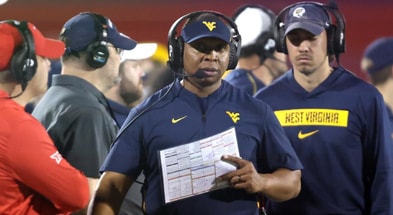The SEC and Big 10 are about to flex their muscle and significant changes to Texas' schedule could result

Last Friday, Inside Texas’ Eric Nahlin reported that there was “a lot of confidence the SEC will move to a nine-game conference schedule in 2026.” One of the more controversial issues for the Southeastern Conference and its 16 members, a nine-game league slate is seemingly on its way.
[BOOKMARK: Check Inside Texas daily for FREE Texas Longhorns content]
But it’s not because the SEC wants to finally catch up to its peers in the Big 10, the Atlantic Coast Conference, and the Big 12 that already make its members play nine league games. It’s because the SEC, in tandem with the Big 10, are about to exercise oligarchical control over college football and the way it crowns a champion in a quest for more revenue.
Yahoo Sports’ Ross Dellenger corroborated IT reporting on Sunday night in saying there was momentum for a nine-game SEC schedule, but added it was due to the likely effects from a memorandum of understanding signed by college football’s power-brokers that essentially hands authority over the future of the College Football Playoff to the two premier leagues in the sport: the Big 10 and the SEC. One main result is the College Football Playoff moving to a 14- or 16-team Playoff beginning in 2026, with the Big 10 and the SEC each receiving four automatic bids and a significantly larger portion of revenue from the CFP compared to the Big 12 or the ACC.
Dellenger’s report explains why the move the nine games is likely.
The [SEC]— the self-proclaimed king of the sport — has, for more than two years now, seriously explored moving from eight to nine league games. However, conference administrators have remained split on the matter. There is fear in sustaining more defeats, which could cost playoff spots. Administrators also are requesting more revenue from ESPN, perhaps as much or more than $5 million a school annually to play an extra league game.
There’s also this added piece of information that borrows an idea from the world of college basketball.
A ninth SEC conference game would then set in motion a scheduling agreement with the Big Ten, which itself already plays nine league games. The scheduling agreement, though still in the discussion stages, would pit SEC and Big Ten teams against one another in annual games to be sold as a separate television package.
The additional conference game is something Texas is prepared for. From 2026 through 2030, Texas has three non-conference games scheduled for each season. A ninth SEC game could fill the remaining open spot, but if the momentum for the additional conference game suddenly stops the Longhorns are more than capable of adding a team in short order.
Nine conference games are something Texas has had no issue with in the past while in the Big 12 and no issue with in the future in the SEC. IT reported Friday that both the Longhorns and the Oklahoma Sooners are in favor of a nine-game schedule. With the Red River Shootout in Dallas at least until 2036 and with neither team interested in moving the game from the Cotton Bowl, a ninth conference game would eliminate the home-road imbalance currently part of Texas’ eight-game slate.
The SEC has rules mandating its teams play at least one Power Conference team in non-conference play. There’s multiple ways to go about this. The Longhorns do it one way, as seen by their willingness to schedule teams like Michigan, Ohio State, Notre Dame, and Arizona State on their future non-conference schedules. Some teams go a different direction, with Ole Miss’ decision to schedule Wake Forest in 2024 a good example of the opposite way of thinking.
Top 10
- 1New
Bracketology update
No. 1 seeds change in update
- 2Trending
Stolen cars
Carson Beck, Hanna Cavinder cars stolen
- 3
Texas football
Longhorns cancel spring game
- 4
CFP seeding
SEC, Big Ten make hopes clear
- 5
Clipboard smash
Auburn mocks Nate Oats over clipboard fury
Get the On3 Top 10 to your inbox every morning
By clicking "Subscribe to Newsletter", I agree to On3's Privacy Notice, Terms, and use of my personal information described therein.
Of course, there are a number of variables the entire league has to consider. Kentucky, South Carolina, Florida, and Georgia are able to satisfy the Power Conference requirement thanks to annual games versus in-state rivals in the ACC.
The Big 10 and SEC may make the teams that like scheduling weaker teams play ball, literally, if the planned crossover between the two leagues happens. That additional revenue would need to come through for the SEC if it were to revamp its lucrative conference championship game and choose a different process for crowning a league champion, an idea Dellenger presented in his reporting.
Could the SEC and Big Ten, if guaranteed four spots, pit their third-best team against the sixth and their fourth-best team against their fifth in on-campus, play-in games to the CFP? Would they advance their top two seeds automatically into the CFP or would they still play a title game? Or, would they match their top seed against their eighth-place finisher?
A nine-game schedule does Texas a lot of good. It keeps the schedule strong in an era when resumes are valued. It keeps the ability to play primary traditional rivals like Oklahoma, Texas A&M, and Arkansas on the table. It provides an extra opportunity for home game revenue against a league opponent on a yearly basis.
[Join Inside Texas TODAY for just ONE DOLLAR PER WEEK!]
And if Yahoo’s reporting is anything to go by, it’s part of a massive change for the future of the sport.
























